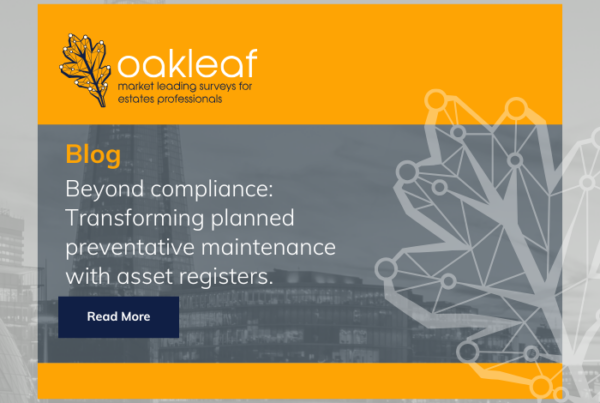Ready to see the full picture of your estate’s health? Rob Wilcox, Head of Fabric Assets, shares how you can get the most out of condition surveys for your buildings.
If you could get a clearer idea of how to maintain your property portfolio better, you’d want to do that, right? Especially if that data came from a trusted process that you’re probably going to have to undertake at some point anyway.
And yet, portfolio managers commonly lose out on the full potential value of a condition survey. This is how to make sure you’re getting key information as early as possible, so you can act with confidence.
First thing’s first, what’s a condition survey?
A condition survey does exactly what it says on the tin. It’s an unobtrusive visual assessment of a property, with a report showing you its current condition. That report should also flag up areas where maintenance and repairs could be needed, immediately or in the near future.
Condition surveys are sometimes also called property appraisals. Either way, they look at elements like:
- Physical structure
- External fabric including windows and doors
- Roofs and associated elements
- Internal fabric
- External site and grounds
- Mechanical and electrical systems
Optionally, a survey can also include:
- Statutory items
- Health and safety items
- Energy saving recommendations
Typical condition surveys should cover a set period of time. The standard timeframe for a condition survey is five years, as this allows for optimum accuracy. However, Oakleaf work with their clients and offer surveys to suit individual needs. If a 15-year condition survey is required for long-term budget planning, then this is also possible.
What happens during a condition survey?
Condition surveys are fundamentally non-intrusive visual surveys and therefore the impact on your-day-to-day business should be minimal.
A large part of this survey is a conversation between the specialist and client, which ensures unique needs are thoroughly understood and that the data delivered will be of most use to the client.
The best providers will be able to work around your staff, particularly in sensitive locations like hospitals or GP surgeries.
What isn’t contained in a condition survey?
The nature of condition surveys means they’re for spotting maintenance priorities, not necessarily investigating them. If there’s a crack in a wall, for example, it would be flagged up. But finding out the cause of the crack would be beyond the scope of a condition survey.
However, a good provider would support a client to understand what additional specialist surveys or remedial action may be needed.
Condition survey vs estate strategy: What’s the difference?
Condition surveys should inform estate strategy, but they’re only one part of the full strategic picture. Other factors are generally in play too.
Business needs might mean you prioritise maintenance in one area of your site. Universities need to look after front of house, for example. Or you might have a pot of funding that can only be used for one prescribed purpose, like sustainability measures.
Nevertheless, condition surveys are a strong objective snapshot of your property’s health. It’s a good idea to prioritise the recommendations. Oakleaf are experienced in supporting clients through this next step of estate strategy.
What are the benefits of carrying out a condition survey?
After a comprehensive condition survey, you’ll be able to reliably do three things for your building:
- Identify and prioritise any necessary maintenance works
- Plan budgets more efficiently by clarifying the cost of those works
- Get a clearer understanding of what’s changed in your building since the last survey.
Across whole portfolios, condition surveys are a consistent source of actionable insights into dozens, potentially hundreds, of properties. You can plan budgets better, ensure compliance, and time maintenance works to minimise disruption.
What are the challenges of carrying out a condition survey?
In the overwhelming majority of cases, actually carrying out condition surveys is perfectly straightforward. The real challenge for a business lies in how to proactively and efficiently use the survey findings and data.
Data can be used on a granular level for repairs and maintenance alongside forming a wider picture of estate health for future planning and budgeting.
It’s tempting to carry out condition surveys reactively, only when they’re needed to finalise an estate for example. Doing it like this robs you of the opportunity to reap all the benefits we talked about. You’re only finding out after the fact how you could have spent your budget or planned maintenance better.
Five-year programmes of annual 20% resurveys and 80% desktop reviews ensuring an accurate picture is maintained in a time and cost-effective way.
Prioritising condition surveys within your wider estate strategy ensures you’ve always got information you can act on. It’ll also give you a far clearer picture of how your property is changing over time.
Why does the public sector trust Oakleaf for condition surveys?
Our team’s experience with condition surveying is particularly strong across the public sector, education, local authority and healthcare sectors.
Knowing these sectors so well, we can tailor our output for a specialised, superior quality report. In-house surveyors located around the country add even greater value using their local knowledge.
We’re also lucky to have the support of our wider brand family, including technology specialists like Concerto and Mobiess. Our hand-crafted approach to condition surveying is compatible with our own specialist technology alongside any CAFM system. You’re getting expert scrutiny with meticulous attention to detail, and it all just works with whatever you’re using in house.
Managers of big, complex portfolios are already getting a clearer picture of their properties, in partnership with Oakleaf. Can we help you achieve the same? It all starts with a conversation.




 Find us on LinkedIn
Find us on LinkedIn